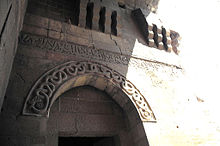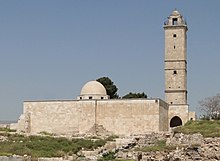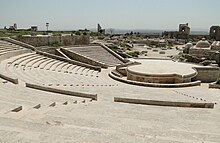Aleppo Citadel
| Aleppo Citadel | ||
|---|---|---|
|
The citadel of Aleppo |
||
| Alternative name (s): | Arabic قلعة حلب, DMG Qalʿat Ḥalab | |
| Conservation status: | Partly ruin | |
| Geographical location | 36 ° 11 '58 " N , 37 ° 9' 47" E | |
| Height: | 431 m | |
|
|
||
The Citadel of Aleppo ( Arabic قلعة حلب, DMG Qalʿat Ḥalab ) stands on a hill ( Tell ) in the middle of the old town of Aleppo in northern Syria . It is considered to be one of the oldest and largest fortresses in the world. The earliest traces of settlement lead back to the middle of the third millennium BC. The place was inhabited by many civilizations, including the Greeks , Byzantines , Ayyubids and Mamluks . Most of today's buildings and fortifications probably date from the Ayyubid period in the 13th century. Major restoration work took place in the mid-2000s and was carried out by the Aga Khan Trust for Culture and the Aleppo Archaeological Society . The citadel, which dominates the old city, is a tourist attraction and a site of excavations and archaeological studies. It has been part of the UNESCO World Heritage since 1986 . In the current civil war , the citadel was badly damaged.
history
Hurrians, Hittites, Assyrians and Persians
In the cuneiform texts of Ebla and Mari a main shrine of the weather god Adad was mentioned in Aleppo. This temple from the third millennium BC was discovered at the end of the 20th century. Aleppo later became the capital of the Yamchad Empire (19th to 17th centuries BC). According to a popular story, the name Aleppo is derived from the fact that Abraham milked his sheep on the hill. Aleppo was dominated several times by the Hittites . In the second half of the 14th century, Šuppiluliuma I established a secondary school under his son Telipinu . This is mentioned on an inscription on the south wall of the al-Qaiqan mosque in Aleppo. After the collapse of the late Hittite state of Ḫalpa / Aleppo, the Assyrians dominated the region (8th to 4th centuries BC), which were then replaced by the Babylonians and the Persians (539 to 333 BC).
Seleucids
After Aleppo was conquered by Alexander the great , the city was administered by his general Seleukos I - the founder of the Seleucid Empire - and renamed "Beroia". The Seleucids built a city based on the Hellenistic model between the citadel and the river. Medieval Arab historians report that the history of the citadel began under Seleucus I. Settlement layers up to 2 meters thick from this Hellenistic era can be found in some parts of the citadel. A colonnaded street from this period led up to the citadel from the west; the Souk of Aleppo is on this road network.
Rome and Byzantium
The last Seleucid was born in 63 BC. Deposed by the Romans. When Emperor Julian visited Aleppo in 363, he said: "I stayed there for a day, visited the Acropolis , sacrificed a white bull to Zeus according to imperial custom and spoke briefly with the city council about the cults of the gods". There are few Roman relics in the citadel. After the division of the Roman Empire in 395 , Aleppo became part of the Eastern Roman Empire . During the fighting between Ostrom and the Persian Sassanids under Chosrau II in the 7th century, the townspeople fled to the citadel because the city walls were in poor condition. There are a few remains from Byzantine times. Two mosques turned out to be converted Byzantine churches.
Early Islamic rulers
Muslim armies conquered Aleppo in 636. Little is known of this early Islamic period, except that repairs were carried out after a major earthquake. Aleppo was a border city between the Arabs and Byzantium. In 944 the Hamdanid Saif ad-Daula conquered the city, after which Aleppo experienced a political and economic revival as its capital. The Hamdanids built their palace on the river, but had to move their palace to the citadel after attacks by the Byzantines in 962. The Hamdanids were followed by a period of instability, marked by Byzantine and Bedouin attacks, and a brief period of Fatimid rule .
Zengids and Ayyubids
The citadel had its most important period during the Crusades . The Zengide Imad ad-Din Zengi and his son Nur ad-Din united the areas around Aleppo and Damascus and prevented incursions by the crusaders. Many famous crusaders were imprisoned in the citadel, such as the Count of Edessa Joscelin II , who died here, the Prince of Antioch , Renaud de Châtillon and the King of Jerusalem , Baldwin II , who spent two years here. Nur ad-Din rebuilt the city walls and fortified the citadel. He built the ramp to the entrance of the citadel, a palace and a racing track. He also had the two mosques repaired and donated a wooden mihrab for the Abraham Mosque. This mihrab disappeared during the French mandate in the 20th century.
The Ayyubide az-Zahir Ghazi , the son of Saladin , dominated Aleppo between 1193 and 1215. During his reign, more work has been at the attachment of the Citadel conducted and new buildings built, Citadell got its present form. Az-Zahir Ghazi strengthened the walls, smoothed overhanging parts and covered the slope of the hill at the entrance with stones. The moat was deepened, connected with water canals and spanned with a large viaduct , which still serves as the entrance to the citadel. At the beginning of the 13th century the citadel was transformed into a palace city with many different functional buildings: palaces, baths, mosques, shrines, arsenals, military training areas, water cisterns and granaries . Most important was the renovation of the entrance area in 1213. Az-Zahir Ghazi restored the two mosques and expanded the city walls, which now also encompassed the southern and eastern parts of the city, thus moving the citadel more into the center of the city.
Mongols and Mamluks
The citadel was damaged during the Mongol invasion of Syria in 1260 and destroyed again around 1400/1401 by Timur from Central Asia. In 1415 the Mamluk prince Saif ad-Din Dschakam set about rebuilding the citadel. Aleppo was then a large trading city with 50,000 to 100,000 inhabitants. Jakam's work included two new observation towers on the north and south slopes and a new palace on top of a tower; the Ayyubid palace was almost completely abandoned. The Mamluk Sultan al-Ghuri replaced the flat roof of the throne room with a new ceiling with new domes.
Ottoman Empire
During the Ottoman rule , the military role of the citadel declined as the city grew beyond the city walls and Aleppo became more and more of a major city. The citadel was still used to house the Ottoman garrison. The size of the garrison is unknown. A Venetian traveler reported about 2,000 people living inside the citadel in 1556; In 1679, the French consul Laurent d'Arvieux spoke of 1,400 people, 350 of whom were Janissaries (Ottoman elite soldiers). Sultan Suleyman I restored the citadel in 1521.
In 1822 an earthquake severely damaged the citadel and city. After that, only soldiers lived in the citadel, the Ottoman governor Ibrahim Pascha had the stones of the destroyed buildings used to build barracks. Under Abdülmecid I the citadel was renovated in 1850/51, a windmill probably dates from this time.
French mandate
During the French rule (1920–45) the French also had their soldiers stationed in the citadel. They began archaeological excavations and extensive restoration work in the 1930s. The Mamluk throne room has been extensively restored, including a new 19th century Damascus ceiling.
Syrian civil war
Aleppo has been a contested city since the civil war in 2012. Much of the old building fabric was damaged or destroyed. The citadel was also affected. On July 12, 2015, it was badly damaged by an explosion. The Syrian Observatory for Human Rights announced that the outer wall collapsed after the Syrian government forces blasted a tunnel used by the insurgents. According to a press release from the Syrian news agency, however, rebels are responsible for the damage. The adjacent historical bazaar was largely destroyed by a large fire on the night of September 28-29, 2012, which had apparently been triggered by fighting. The city has been under full government control since 2016, and repairs have begun across Aleppo.
construction
Among the numerous structural elements of the citadel, the following are particularly noteworthy.
Hill and moat
Today's citadel sits enthroned on a 50-meter-high hill, the base of which is 450 × 325 meters. The area of the citadel itself is 285 × 160 meters. In the past the slope of the hill was completely covered with limestone ; However, not much remains of this disguise.
A ditch 22 m deep and 30 m wide runs around the hill. The paved access with the bridge over the moat is striking. The access in front of the viaduct dates from the 16th century.
Entrance area
The enormous stone bridge of az-Zahir Ghazi leads to an imposing entrance complex. In order to penetrate the citadel, possible attackers had to take a path that was angled several times: only after a sequence of five right-angled turns and three large gates did you get to the entrance of the inner main castle. Defenders could pour hot liquids over the attackers through machiculi (openings) in the walls. In addition, the defenders had secret ways to get behind the attackers. The main path was decorated with figurative reliefs. The Mamluks later built their throne room on top of these Ayyubid buildings.
Ayyubid palace and hammam
Az-Zahir Ghazi's own Palace of Glory burned down on his wedding night, but has been rebuilt and is one of the most impressive and important monuments in the citadel. An entrance portal with honeycomb muqarnas decor and a tiled inner courtyard also date from the Ayyubid period .
The medieval hamam was built in the traditional style and therefore had three sections: In the first one changed clothes and rested, in the second there was a warmed room, which was then followed in the third section by a hot room and a steam room with niches. Cold and hot water were passed through ceramic pipes.
Mosques
In the citadel there are two mosques that were once Byzantine churches: the Abraham Mosque and the Great Mosque. The highest point of the citadel is the 21 m high minaret of the Great Mosque.
Wells and underground passages
The citadel not only has structures on the surface, but several wells were driven up to 125 m below the surface. There are also underground passages that connect the towers and perhaps even lead under the moat into the city.
amphitheater
In 1980 a modern theater for events and concerts was built in the citadel .
Individual evidence
- ^ Ancient City of Aleppo . UNESCO ( whc.unesco.org [accessed March 7, 2012]).
- ^ Temple of Hadad in Aleppo Citadel Sheds Light on Important Periods. In: DayPress News. January 16, 2010.
- ↑ a b c d e Bianca and Gaube, 2007, pp. 73-103.
- ↑ H. Th. Bossert: Comments on a hieroglyphic Hittite inscription from Aleppo . In: Syria . tape 31 , no. 3 , 1954, ISSN 0039-7946 , p. 225-253 .
- ↑ a b c d e Gonnella, 2008, pp. 12-13.
- ↑ Gonnella, 2008, p. 11.
- ^ Ross Burns: Monuments of Syria. To Historical Guide . Tauris, London.
- ↑ a b c Gonnella, 2008, pp. 14-19.
- ^ A. Hourani: A History of the Arab Peoples . Warner, New York 1992.
- ↑ Gonnella, 2008, pp. 19-20.
- ↑ a b Gonnella, 2008, pp. 21-24.
- ↑ Citadel of Aleppo badly damaged by explosion. - derStandard.at.
- ↑ Unesco calls the destruction in Aleppo a tragedy. In: Der Spiegel. September 30, 2012.
- ↑ a b c Gonnella, 2008, p. 25.
- ↑ Gonnella, 2008, pp. 31-35.
- ↑ a b c Gonnella, 2008, pp. 46-48.
literature
- Julia Gonnella , Wahid Khayyata, Kay Kohlmeyer : The Citadel of Aleppo and the Temple of the Weather God. New research and discoveries. Rhema-Verlag, Münster 2005, ISBN 3-930454-44-0 .
- Stefano Bianca (Ed.): Syria. Medieval Citadels Between East and West . Allemandi, Turin 2007, ISBN 978-88-422-1449-6 ( archnet.org ).
- Julia Gonnella : The Citadel of Aleppo. Description, History, Site Plan and Visitor Tour. (Guidebook) . Aga Khan Trust for Culture and the Syrian Directorate-General of Antiquities and Museums, Geneva 2008, ISBN 978-2-940212-02-6 ( archnet.org ).










